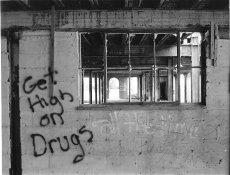Now I will "out" me. Around 20 years before in the time when I was studying photoengineering in Cologne, I was the printer for Mr. Wilde, the owner of Renger-Patzsch and Blossfeldt-Archive. Now Mr Moersch is doing this job. I for myself had used lf-cameras up to german format 40x50 centimeter and I have a collection of around 300 lf-optics in the history of photo-optic - mostly lf-optics. I love lf, but getting older you cannot carry so much. Thats the way, the Gigabitfilm came up.
One client from me, a long experiend professional photographer, Mr Boehme, had made once time - just for fun - two photos from the same object - one in 35mm on my film, the other on 18x24 centimeter (little less than 8x10") T-Max 100. And the T-Max negative is absolutely correct and also absolutely correct printed. The one picture he enlarged on 24x30 centimeter, the other on 30x40 centimeter. When I was on the forums for fine-print here in Germany all the years, I showed these examples to the leading experts in middle-europe. Only one -ONE- of them, Mr. Weidner, was able to say after 30 seconds looking on these photographies, which could be 35mm and what was lf. All - I mean really ALL!! - other experts were always showing on the 35mm photo saying thriumphantly: "This is largeformat!" You can find this example on my website.
To get this quality, a lot of high tec knowledge must be there, and a lot of "wrong" thinking in bw-photography must change. The list is long with all the mistakes, but since 2000 it is possible to get this quality. And I knew people in USA, who say, that they are doing their job with middleformat or more, but the reality is more little.
Resummee for your question: with the new generation of my films it is possible to get in 35mm the quality of minimum 6x7cm/4x5", depending on optic-stop and structure of the motive up to just 8x10". You need not always a tripod as with the once TechnicalPan, this has to do with blurr and too strong edge-effects. With 4x5" Gigabitfilm-negative you can get the quality of perhaps 11x14" or bigger, but high-tec precision in lf-camera will be a problem - the parallelity-problem for infinity as an example. Clients of mine, asking for Gigabitfilm 4x5", I always ask, what cameras they have. If only optical bench camera, I say: No sense, planparallelity is too low. This Gigabitfilm makes only sense 1. in cameras like Technika-Style, 2. in landscape where the motive is in infinity, 3. stopping down not over 1:16 or lower, than you can get -in summary- a resolution and grayscale - on the limits of optical physics. And your enlarger must be absolutely correct in parallelity, and a lot of the older enlarger are not, you must corrigate this. And 25 ISO make not so much fun, but works in sunny areas.













